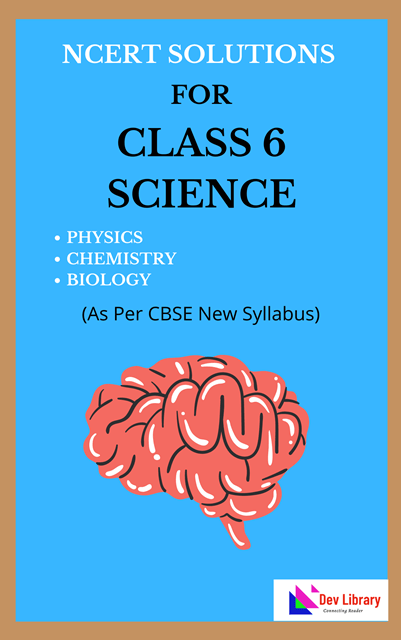NCERT Class 6 Science Chapter 11 Light, Shadows and Reflections of Distances Solutions to each chapter is provided in the list so that you can easily browse through different chapters NCERT Class 6 Science Chapter 11 Light, Shadows and Reflections of Distances and select need one. NCERT Class 6 Science Chapter 11 Light, Shadows and Reflections of Distances Question Answers Download PDF. NCERT Class 6 Science Solutions.
NCERT Class 6 Science Chapter 11 Light, Shadows and Reflections of Distances
Also, you can read the NCERT book online in these sections Solutions by Expert Teachers as per Central Board of Secondary Education (CBSE) Book guidelines. CBSE Class 6 Science Solutions are part of All Subject Solutions. Here we have given NCERT Class 6 Science Chapter 11 Light, Shadows and Reflections of Distances and Textbook for All Chapters, You can practice these here.
Light, Shadows and Reflections of Distances
Chapter: 11
NCERT TEXT BOOK EXERCISES
Q. 1. OWS AKE OPAQ UEO TSM SHAD
Ans: OPAQ UEO BJEC TSM AKE SHAD OWS.
Q. 2. Classify the objects or materials given below as opaque, transparent or translucent and luminous or non-luminous:
Air, water, a piece of rock, a sheet of aluminium, a mirror, a wooden board, a sheet of polythene, a CD, smoke, a sheet of plane glass, fog, a piece of red hot iron, an umbrella, a lighted florescent tube, a wall, a sheet of carbon paper, a flame of a gas burner, a sheet of card board, a lighted torch, a sheet of cellophone, a mix mesh, kerosene stove, sun, firefly, moon.
Ans: (i) Opaque things: A piece of rock, a sheet of aluminium, a mirror, a wooden board, a wall, a sheet of card board.
(ii) Transparent things: Air, water, a sheet of plane glass.
(iii) Translucent things: A sheet o polythene, a CD, smoke, fog, a sheet o carbon paper, a sheet of cellphone.
(iv) Luminous things: A piece of red hot iron, a lighted florescent tube, the flame of a gas burner, a lighted torch, sun, firefly, moon.
(v) Non-luminous things: An umbrella, a wire mesh, kerosene stove.
Q. 3. Can you think of creating a shape that would give a circular shadow if held in one way and a rectangular shadow if held in another way?
Ans: Yes, there are many things which give a circular shadow if held in one way and a rectangular shadow if held in another way. For example, a cylinder, circular disc etc.
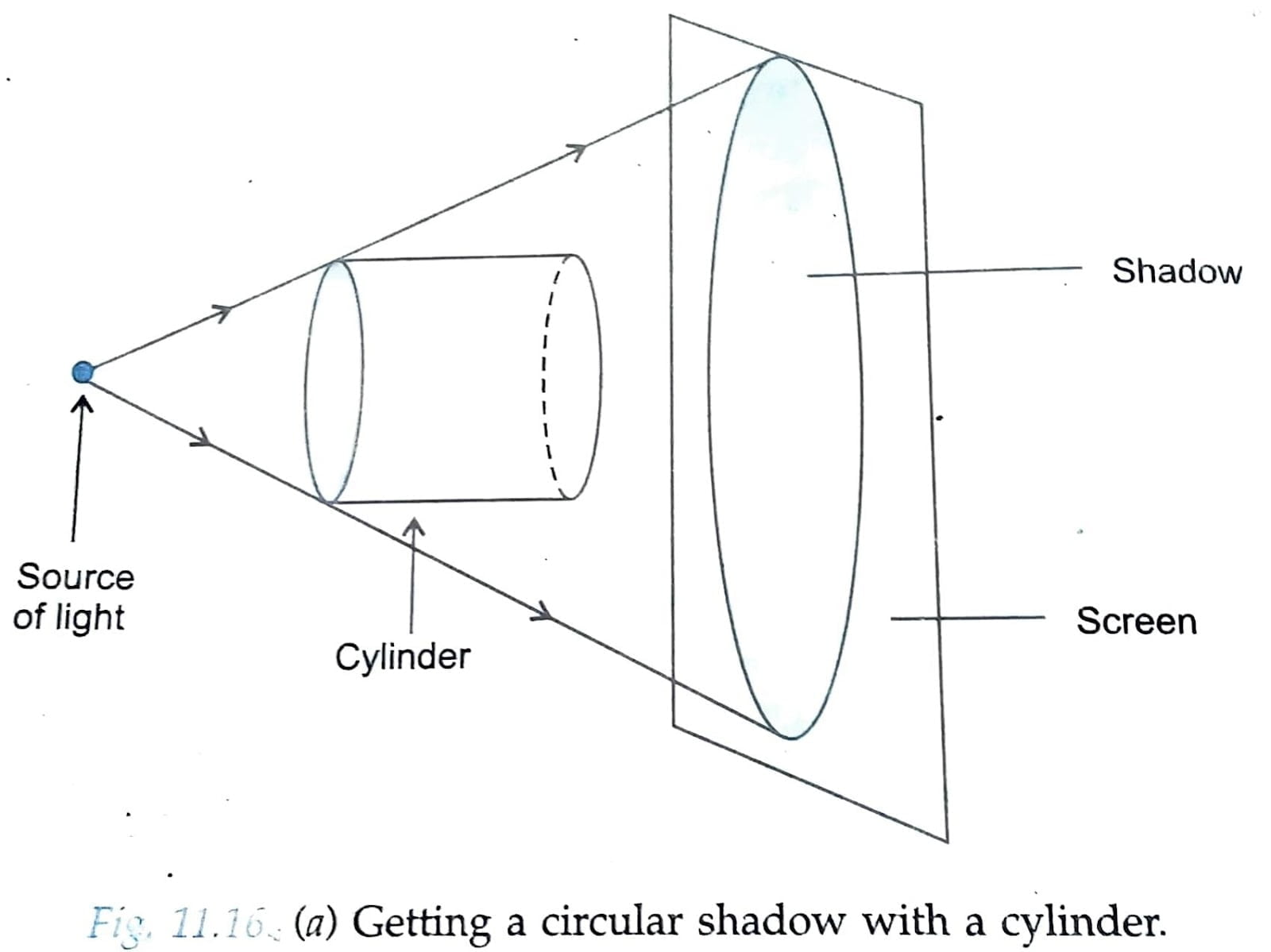
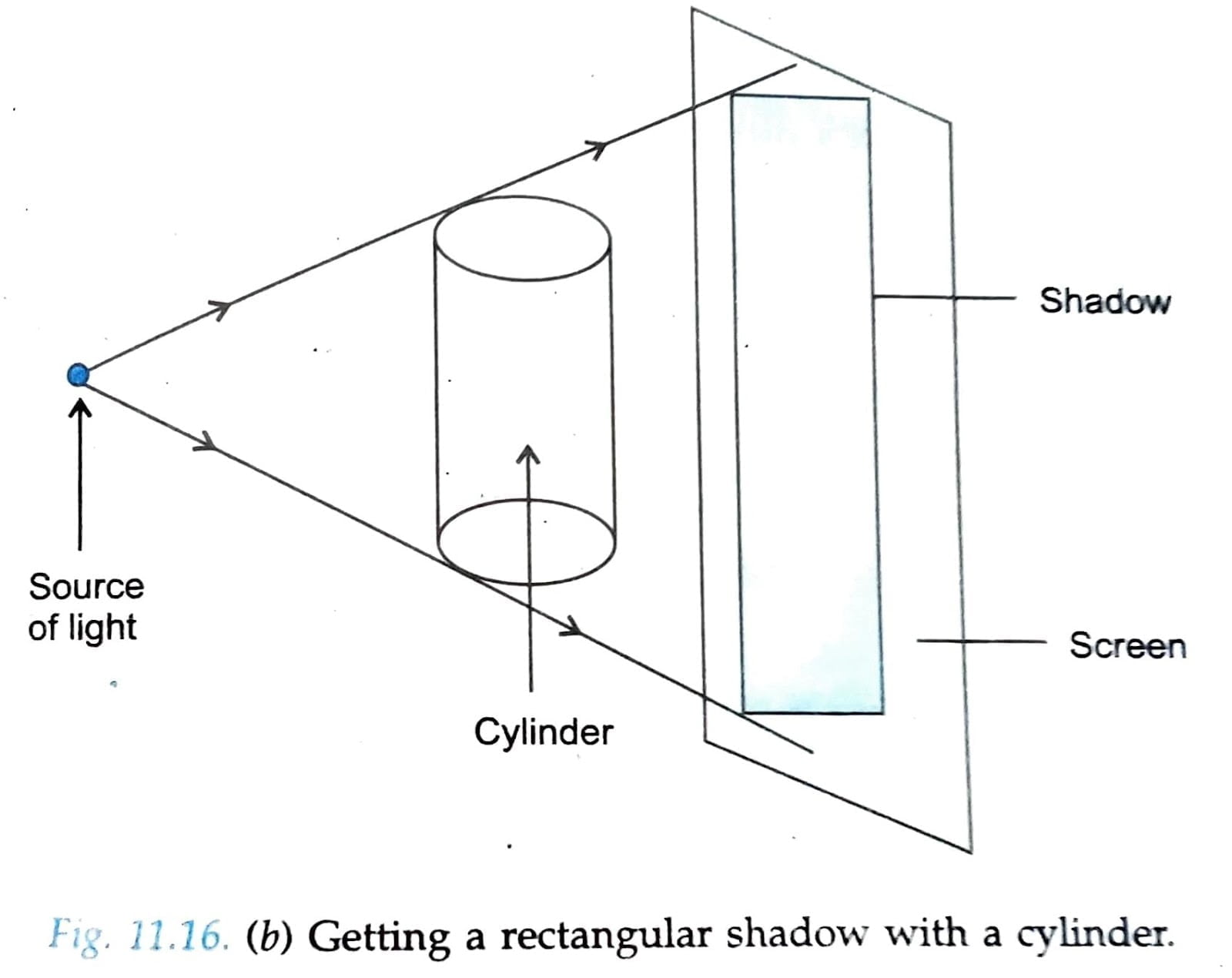
Q. 4. In a completely dark room, if you hold up a mirror in front of you, will you see a reflection of yourself in the mirror?
Ans: No. A mirror forms the reflection of an illuminated object in front of it. Since the room is completely dark, there is no source of light to illuminate our body. Thus we cannot see a reflection on ourselves in mirror.
SOME OTHER IMPORTANT QUESTIONS FOR EXAMINATION
VERY SHORT ANSWER QUESTIONS
Q. 1. Name the most important source of light for the earth.
Ans: Sun.
Q. 2. Name the natural sources of light.
Ans: Sun, stars.
Q. 3. What name is given to the object through which we cannot see at all?
Ans: Opaque.
Q. 4. What name is given to the object through which we can see but not clearly?
Ans: Translucent.
Q. 5. What name is given to the object through which we can see clearly?
Ans: Transparent.
Q. 6. Give one example of an object through which we can see clearly.
Ans: Glass.
Q. 7. Give one example of an object through which we can see but not clearly.
Ans: Ground glass.
Q. 8. Give one example of an object through which we cannot see at all.
Ans: Cardboard.
Q. 9. On what principle does, a pinhole camera work?
Ans: The pinhole camera works on the principle that light travels in straight lines.
Q. 10. How are shadows formed?
Ans: Light coming from the source of light falling on the objects obstructed by the objects and does not go ahead. So a shadow is formed.
Q. 11. Are the edges of shadow sharp and distinct?
Ans: Yes, the edges of the shadow are sharp and distinct.
Q. 12. Does the direction of shadow change during the day?
Ans: Yes, the direction of shadow changes because the position of the sun changes during the day.
Q. 13. What is the colour of shadow formed:
(a) if the colour of object is white?
Ans: Black.
(b) if the colour of object is red?
Ans: Black.
Q. 14. What is umbra?
Ans: Umbra is the dark region behind object facing light which does not receive light at all.
Q. 15. What is penumbra?
Ans: A region of partial darkness which surrounds the umbra is called penumbra, some light rays reach this region.
Q. 16. What is the essential condition for shadow formation?
Ans: A shadow is formed only when there is surface/screen behind the opaque object.
Q. 17. How does a light ray travel?
Ans: Light ray travels in a straight line.
Q. 18. Why can we protect our eyes while glaring at a strong source of light by placing our hand in front of eyes?
Ans: Light travels in a straight line. On placing hand in front of our eyes, light coming from the source does not fall on our eyes directly.
Q. 19. Does the length of shadow change from season to season?
Ans: Yes, the length of shadow changes from season to season.
Q. 20. What do we call a body that shines of its own?
Ans: Luminous body.
Q. 21. What type of screen is used in a pinhole camera: transparent, translucent or opaque?
Ans: Translucent.
Q. 22. Name a device which can be used to see things on the other side of a high (without having to climb over the wall)
Ans: Periscope.
Q. 23. What is reflection of light?
Ans: The process of sending back the light rays which fall on the surface of an object, is called reflection of light.
Q. 24. If an object is placed at a distance of 10 cm in front of a plane mirror, how far would it be from its image?
Ans: 20 cm.
Q. 25. What are the equipments/ materials needed to show the formation of shadow?
Ans: A bright torch, wall or screen.
SHORT ANSWER QUESTIONS
Q. 1. Why can you see an electric bulb when it is switched on?
Ans: We can see an electric bulb because at night glass is a transparent material which allows all the light coming from the bulb to pass through it.
Q. 2. Name any two features of the image formed by a plane mirror.
Ans: (i) The image formed by a plane mirror is as far behind the mirror as the object is in front of it.
(ii) The in a plane mirror is of the same size as the object.
Q. 3. Give two effects of light on plants.
Ans: (i) Plants use light energy to prepare. their own food.
(ii) The tips or shoot apex of a photogenic plant moves towards it. Light acts as a stimulus to plants.
Q. 4. State two differences between transparent and translucent objects.
Ans:
| Transparent objects | Translucent objects |
| 1. They allow light to pass through them easily. | 1. It allows a part of light to pass through it. |
| 2.Objects can be seen easily though them. | 2. Objects through them can only be seen dimly. |
Q. 5. Give two important differences between the pinhole image and the shadows.
Ans: The important differences between the pinhole images and the shadows are:
(i) The pinhole image of an object is inverted whereas the shadow of an object is erect.
(ii) The pinhole image of an object is of the same colour as the object but the shadow of an object is always black.
Q. 6. What are luminous bodies? Give two examples.
Ans: The bodies which emit their own. light are called luminous bodies.
Examples: The sun, burning candle.
Q. 7. How will you convert a glass sheet into a translucent sheet?
Ans: Following are the methods to convert glass sheet into a translucent sheet:
(i) By smearing a thin layer of oil on glass sheet.
(ii) By covering a side of sheet by butter paper.
Q. 8. Draw a diagram to show the working of a periscope.
Ans:
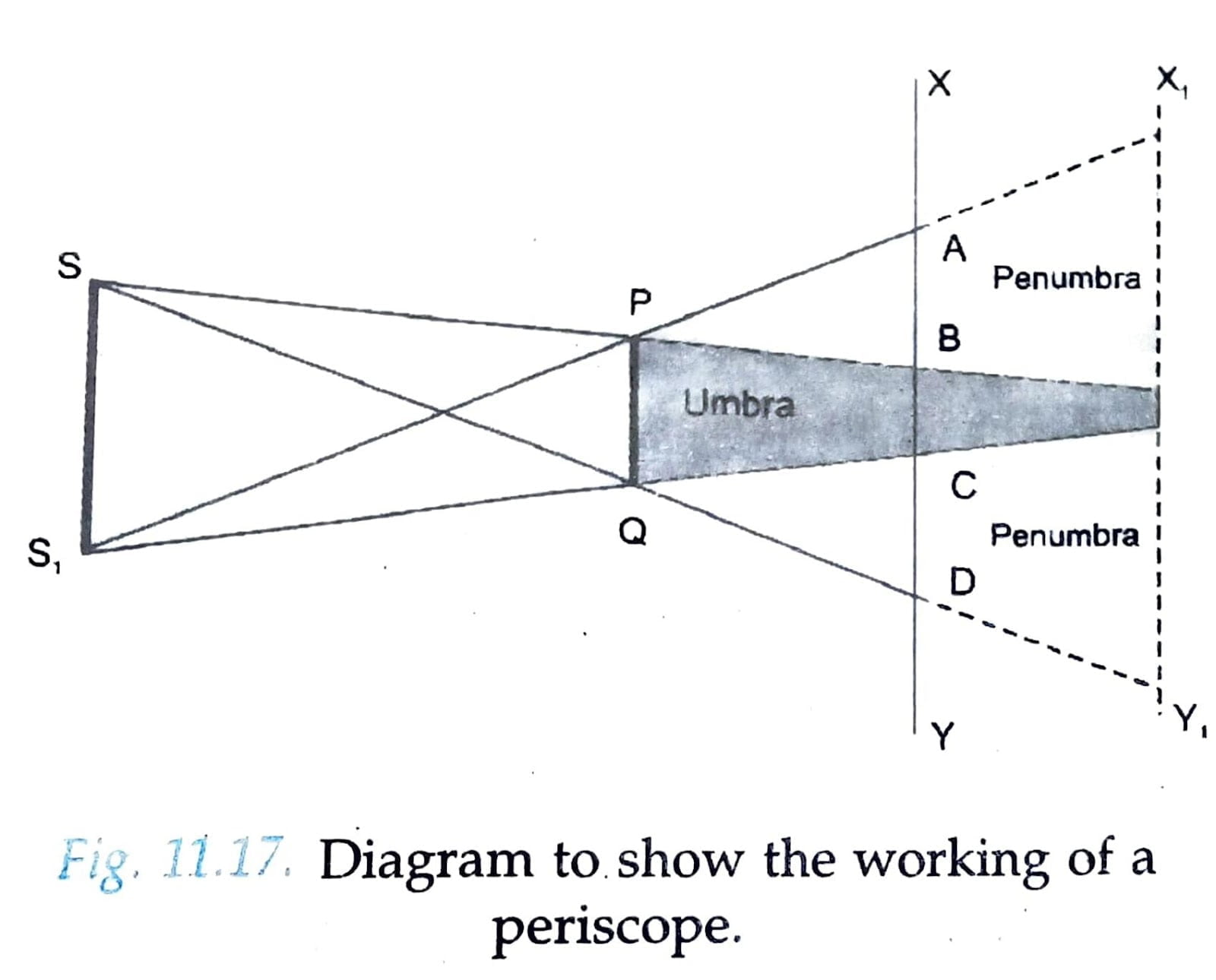
Q.9. On a sunny day, when we pass under a tree covered with a very large number of leaves, often see bright circular patches of light on the ground (under the tree)
(a) What are the bright circular patches of light?
Ans: Pinhole images of the sun.
(b) Name the object (source of light) in this case.
Ans: Sun.
(c) What acts as screen in this case?
Ans: Ground.
(d) Which effect is illustrated by the every- day observation described above?
Ans: Pinhole camera effect.
Q. 10. State two uses of periscope.
Ans: (i) It is used for looking over the heads of a crowd by raising it above the obstacle.
(ii) It is used during trench wars for observing the enemy.
Q. 11. (a) Name two objects which produce their own light.
Ans: The sun, lighted electric bulb.
(b) Name two objects which we see by their reflected light.
Ans: Moon, plants.
Q. 12. Why we can see clearly a burning candle through a sheet of clear glass?
Ans: If we look at a burning candle through a sheet of clear glass, we can see the candle and its flame clearly. This is because glass is a transparent material which allows all the light coming from the candle and its flame to pass through it.
Q. 13. Though we cannot see the s through clouds on a cloudy day but still there is some sun-light all around. Give reason.
Ans: This is because being translucent, clouds allow some of the sunlight pass through them due to which there is light on earth even in a cloudy day.
Q. 14. What would be the shape of an object so that it will cast no shadows on the ground in the light of sun?
Ans: An object casts no shadow (or very little shadow) on the ground sunlight when it is either transparent or it is at such a height from the earth that the umbra does not reach the surface of the earth.
Q. 15. Why is your shadow longest at sunrise and shortest at noon?
Ans: In the morning at the time of sunrise and in the evening at the time of sunset light rays falling on the earth are not straight. They are inclined. This is why our shadow at this time both (morning and evening) is the longest. At noon the sun is just over above our head and sun-rays fall vertically on the earth. Due to the vertical sun-rays, our shadow formed at noon is the shortest.
SHORT ANSWER QUESTIONS
Q. 1. Write three differences between umbra and penumbra.
Ans:
| Umbra | Penumbra |
| 1. It is the darkest part of the shadow. | 1. It is less dark part of shadow. |
| 2. No light reaches to thus region. | 2. Light from some parts of the source reaches |
| 3. It is central part or shadow | 3. It is outer part of a shadow |
Q. 2. A tall device which contains plane mirrors can be used to see over the heads of crowd (say, as in a football match).
(a) What is the name of this device?
Ans: Periscope.
(b) How many plane mirrors does it use?
Ans: Two.
(c) On what principle does this device work?
Ans: Periscope works on the reflection of light from two plane mirrors arranged to one another.
Q. 3. A man is sitting on a chair in a dark room one of the walls. A big mirror is hung on the wall facing the man. a torch light is put on the man from a distance, then we can see X of the man on the wall behind him. At the same time Y of the man can be observed in the mirror on the wall.
(a) What is X?
Ans: Shadow.
(b) What is Y?
Ans: Image.
(c) State one way in which X differs from Y.
Ans:The shadow is black but the image is of the same colour as the man.
Q. 4. Write the differences between shadow and image.
Ans:
| Image | Shadow |
| 1. It is formed by intersection of reflected rays. | 1. It is formed when light does not reach behind the object. |
| 2. Image is seen when reflected rays approach to observer’s eyes. | 2. No light enters the observer’s eyes. |
| 3. Image gives more infor- mation such as colour, structure etc. | 3. Shadow does not provide such information. |
Q. 5. What are the characteristics of the image formed by the pinhole camera?
Ans: Following are the characteristics of the image:
(i) It is real, i.e., it is formed on the screen.
(ii) It is inverted.
(iii) It is generally smaller than the size of the object.
Q. 6. (i) Light enters in a dark room through a small key hole in the door. On the opposite wall is seen an inverted image of a tree outside. Explain this observation.
Ans: The entire room system works as a pinhole camera forming the image of a distant tree outside. The key hole works as a pinhole, room acts as the box of camera and the opposite wall acts as the screen of the camera.
(ii) If a white screen is kept near to the hole, how will the image formed on screen differ from the image formed on wall?
Ans: If a white screen is kept close to key hole, the image formed will be smaller and brighter than that on the wall.
(iii) What will be effect if another hole is drilled along the side of key hole?
Ans: In this condition, two images will be formed which will overlap to form a blurred image.
Q. 7. Light of the sun passing through the leaves of a tree forms the circular or oval patches on the ground. Explain the reason.
Ans: There are many small spaces between the leaves of a tree which act as pinhole. Each pinhole forms a small image of sun which becomes blurred due to over lapping. So, a number of bright circular o oval patches are formed under a tree.
Q. 8. State how the image in a pin hole camera is affected when:
(i) Size of pinhole is increased.
Ans: A pinhole bigger in size produces a blurred image i.e., the edges of the image will not be sharp.
(ii) The distance of the object from the pin- hole is increased.
Ans: The size of the image decreases.
(iii) The distance of the screen from the pin- hole is increased.
Ans: The size of the image increases.
Q. 9. Draw the diagrams showing the formation of shadow by:
(i) A point source.
Ans: (i) Formation of shadow by a point source.
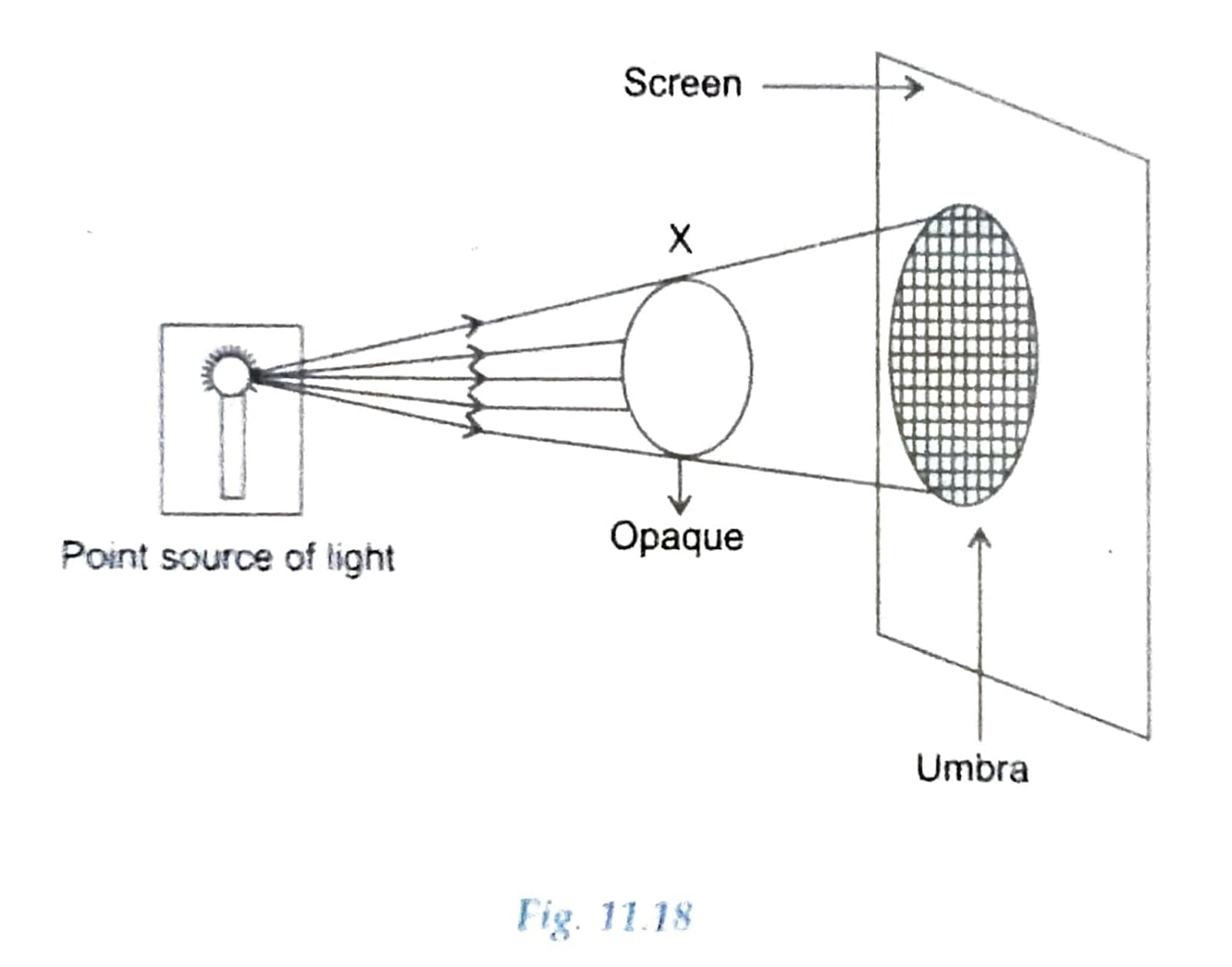
(ii) A source of light smaller than the object.
Ans: Formation of shadow by a source smaller than the object.
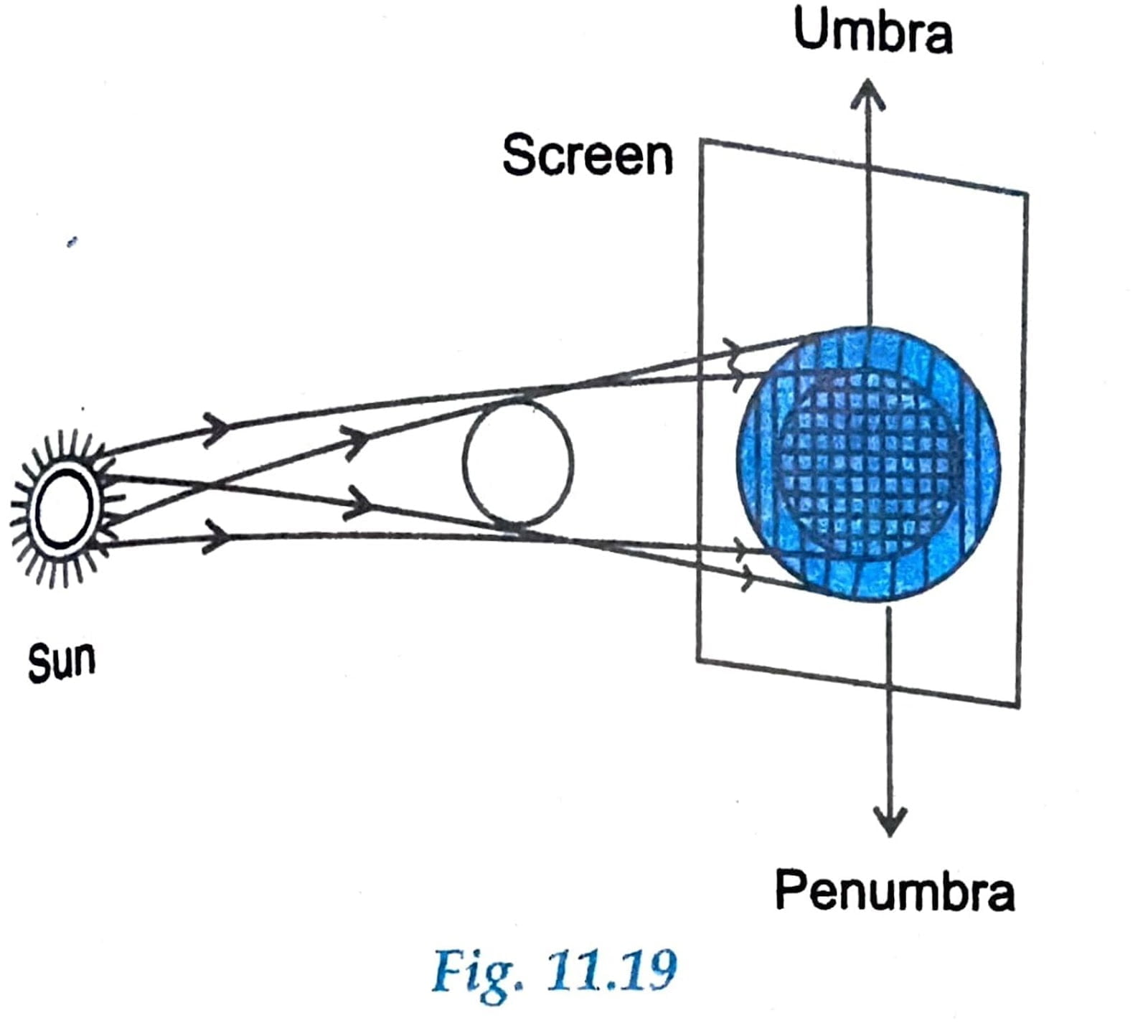
(iii) A source of light larger than the object.
Ans: Formation of shadow by a source larger than the object.
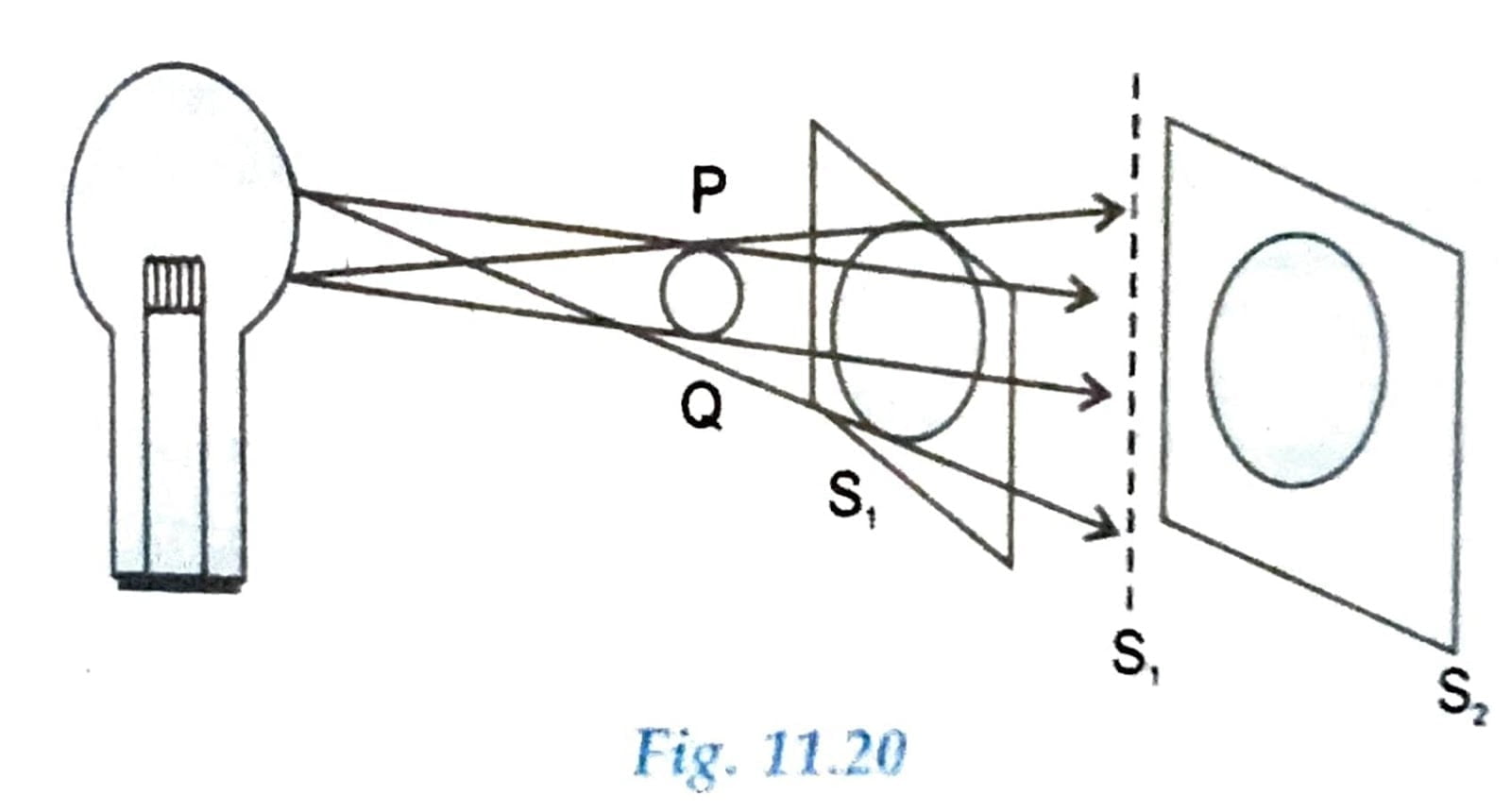
Q. 10. What is shadow? Give the conditions necessary for obtaining a clear and sharp shadow.
Ans: Shadow is a dark (black) patch formed behind any opaque object due to the obstruction of light by that opaque object.
Following are the necessary conditions to make a clear and sharp shadow:
(i) There should be a distinct source of light.
(ii) An opaque body must be present to obstruct the path of light.
(iii) Formation of shadow by a point source.
Q. 11. Distinguish between regular and irregular reflection.
Ans:
| Regular reflection | Irregular reflection |
| 1. It takes place on a smooth and polished surface. | 1. It takes place on a rough surface. |
| 2. The image is formed after reflection. | 2. No image is formed after reflection. |
| 3. Light is reflected back in a definite direction into the same medium. | 3. Light is scattered back into the same medium in all directions. |
Q. 12. What is lateral inversion? Explain.
Ans: When we look in a plane mirror, we see the image of the objects placed in front of it. The left of the object becomes right of the image and the right of the objects becomes left of the image.
This is called lateral inversion.

Q. 13. How can non-luminous bodies be made luminous?
Ans: Any non-luminous body can be made luminous by heating it. Take an iron wire and it on a gas flame. After some time, the iron wire will become red hot and start light. At this point, the temperature of iron is between 600°C to 800°C.
Q. 14. What are non-luminous bodies? Why are the moon and the planets considered as non-luminous bodies?
Ans: Such bodies, which do not give out light of their own, are called non-luminous bodies.
Moon and planets are considered as non- luminous bodies because they do not produce light of their own. Instead, they reflect the light from the sun fall on them. Hence, they are non-luminous bodies.
Q. 15. You have to cast the shadow of your pencil on the wall with the help of candle in a dark room. How can you obtain the shadow of same size, small size and big size of the same pencil?
Ans: (a) The shadow of the pencil will be small when the pencil is taken close to the wall and away from the candle.
(b) The shadow will be big in size when the pencil is taken closer to the candle.
(c) To get the same sized shadow as the pencil is, adjust the distance between the wall, pencil and candle at equal distances.
Q. 16. Why do the birds flying high in the sky not cast their shadows?
Ans: The bird is too small as compared to the diameter of sun. The umbra formed by the bird is so small that it finishes in the air. The penumbra formed by it is very large and very faint. Thus, it is hardly visible. Hence, on the whole, no shadow is formed on the Earth. Therefore, birds flying high in the sky do not cast their shadows.
LONG ANSWER QUESTIONS
Q. 1. What is meant by:
(a) Real images and (b) Virtual images? Give one example each of a Real images and a virtual image.
Ans: (a) Real image: The image which can be obtained on a screen is called a real image. In a cinema hall, we see the images of actors, on the screen. So, the images formed on a cinema screen is an example of real image. A real image is formed when light rays from an object actually meet at a point after reflection from a mirror (or refraction a lens). A real image can be formed on a screen because light rays actually pass through a real image.
The image which cannot be obtained on a screen is called a virtual image. A virtual image can be seen only by looking into a mirror. The image of our face formed by a plane mirror cannot be obtained on a screen, it can be seen only looking into the mirror.
So, the image of our face in a plane mirror is an example of virtual image. A virtual image is formed when light rays coming from an object only appear to meet at a point when produced backwards.
Q. 2. Define the structure and working of a pin-hole camera.
Ans: Pin-hole camera: It is a simple application of the rectilinear propagation of light.
Construction: It consists of a rectangular card board box, such that its one side is made of ground glass screen, the side opposite to ground glass has a hole in the middle, whose size is equal to the pin-head of a common pin. The box is blackened from inside, so as to absorb any light falling on its walls.
Working: (1) Consider a lighted candle AB, in front of pin-hole camera. The rays starting from points of candles, travel in all directions.
(2) A ray of light starting from point ‘A’ along with AH after passing through the pin- hole falls on ground glass screen at point ‘A,
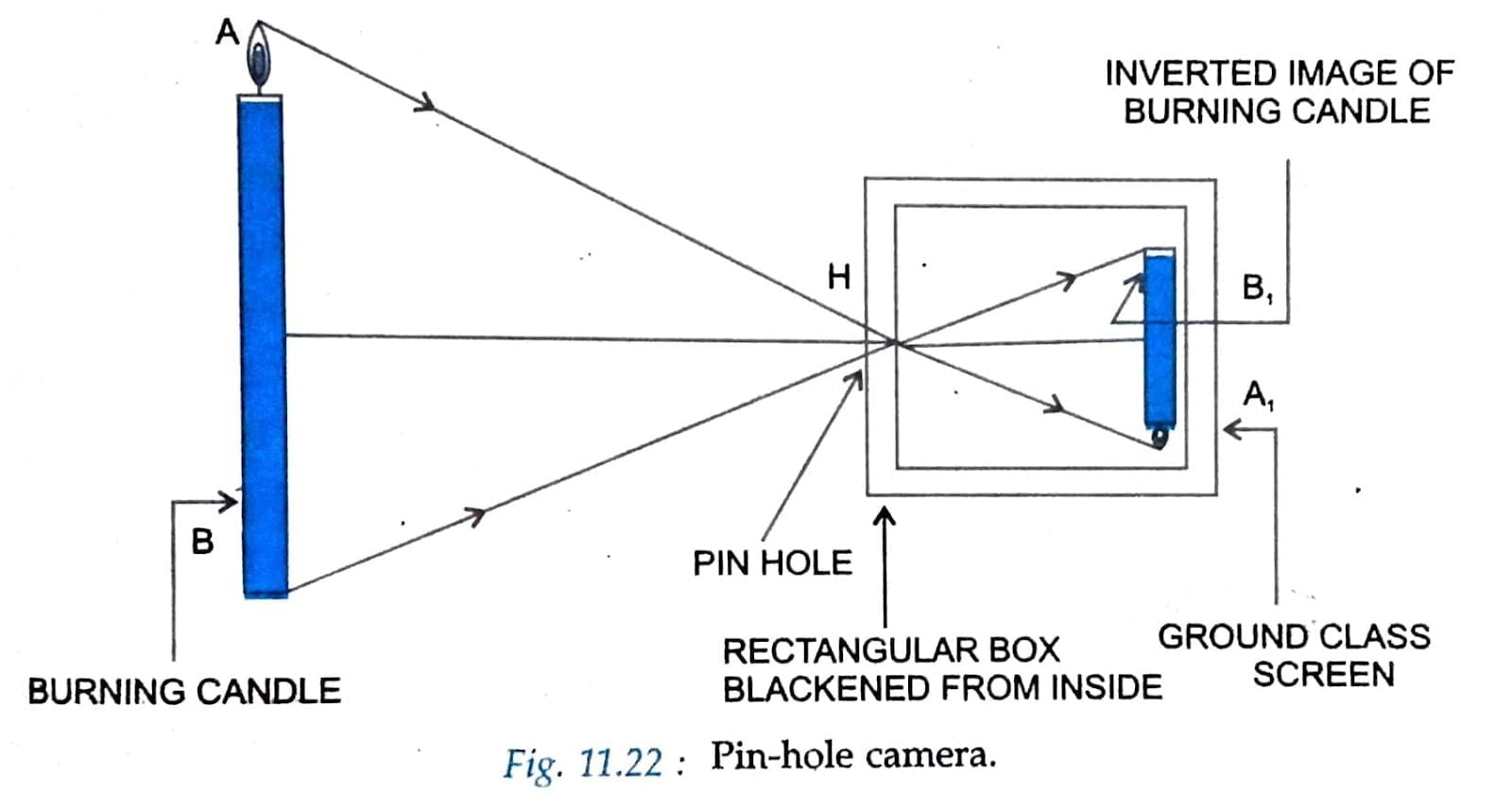
Similarly another ray starting from point Balong with BH after passing through the pin-hole will fall on ground glass screen at point ‘B’.
(3) A,B, is the image of AB. The image formed here is turned upside down, because light travels in straight line.
Q. 3. What is meant by:
(a) transparent materials.
Ans: Transparent materials: Substances which allow light to pass through them easily and through which we can see clearly are known as transparent substances. Air, water, glass, etc., are examples of transparent substances.
(b) translucent materials.
Ans: Translucent materials: Substances which light can pass partially and through which we cannot see clearly are called translucent substances. Wax paper, butter paper, greased paper, etc., are examples of translucent substances.
(c) opaque materials? Give two examples each of transparent, translucent and opaque, materials.
Ans: Opaque materials: Substances which do not allow light to pass through them are
called opaque substances. We cannot see at all through them. Wood, stone are opaque substances.
Q. 4. You see your image in a plane mirror:
(a) State two characteristics of the image formed in a plane mirror.
Ans: (i) The image in a plane mirror is of the same size as the object. It is neither diminished nor enlarged.
(ii) The image formed in a plane mirror is the same distance the mirror as the object is in front of the mirror. But the object and the image are on the opposite sides of the mirror.
(b) State one way in which your image in the plane mirror differs from you.
Ans: The image in a plane mirror is laterally inverted with respect to the object. It is due to lateral inversion that the image of our right hand appears to be our left hand. So when we sit in front of a plane mirror and with our right hand, it appears in the mirror that we are writing with the left hand.
Q. 5. What is by
(a) luminous objects.
Ans: Luminous objects of light are defined as those objects of light which give out light of their own. Examples are sun, lamp, candle, electric bulb, etc.
(b) non-luminous objects? Name two luminous objects and two non objects. State whether moon is a luminous object or a non-luminous object.
Ans: Bodies that do not emit light on their own, but reflect the light falling on them and hence become visible are called non-luminous objects of light. The moon is a non-luminous object of light because it does not produce any light of its own. It reflects the sun’s light. All the planets and moon are reflectors of light. Earth also reflects the light of the sun.
Higher Order Thinking Skill Questions
Q. 1. How does the size of shadow vary when the source is taken away from the object?
Ans: When the source is taken away from the object, the size of the shadow decreases.
Q. 2. What is the main difference between the shadow of a table tennis ball produced by a point source of light and that produced by an extended source of light?
Ans: Shadow of a table tennis ball produced by a point source of light is completely darkened patch i.e., umbra. While the shadow produced by extended source of light has middle region, umbra and boundary region, penumbra.
Q. 3. A circular source of light, bigger than the size of opaque object, is used to form the shadow. What will be the shape of the source when seen from a point just beyond the umbra cone?
Ans: The shape of the source when seen from a point just beyond the umbra cone, will appear as a circular ring.
Q. 4. State the laws of reflection of light.
Ans: (i) The angle of reflection is equal to the of incidence.
(ii) The incident ray, the reflected the normal lie in one plane. ray and
Q. 5. Distinguish between a real and a virtual image.
Ans: A real image can be obtained on a screen. It is formed when the reflected rays actually meet at a point. On the other hand, a virtual image cannot be obtained on a screen. It is formed when the reflected rays do not actually meet at a point, but they meet when they are produced backwards.
Skill Based Questions
Q.1. Observe the diagram given below. does the following activity depict?
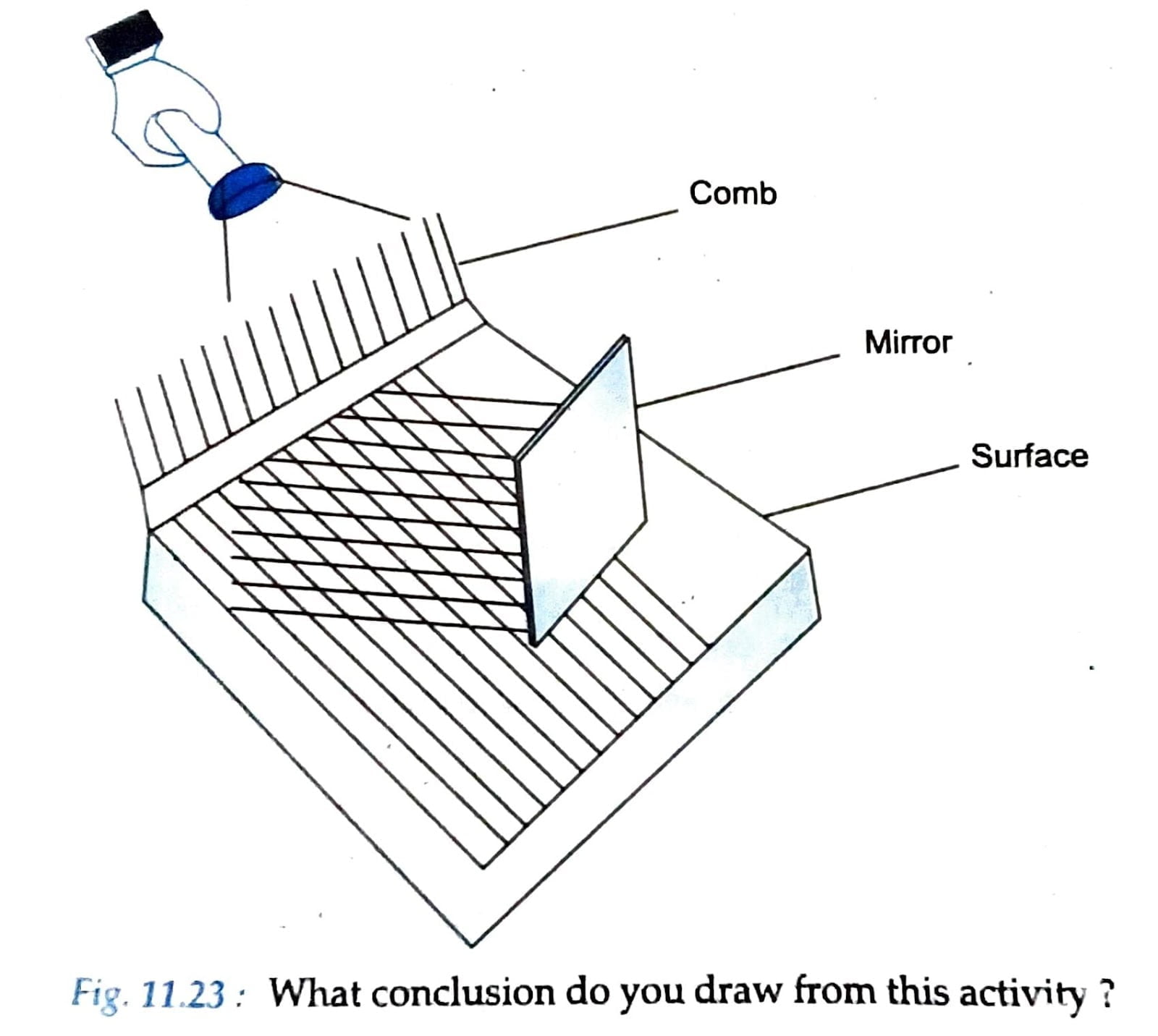
Ans: Light travels in straight line and gets reflected from a mirror.
Q.2. Label 1 and 2 and write correct caption for picture. Give its uses.
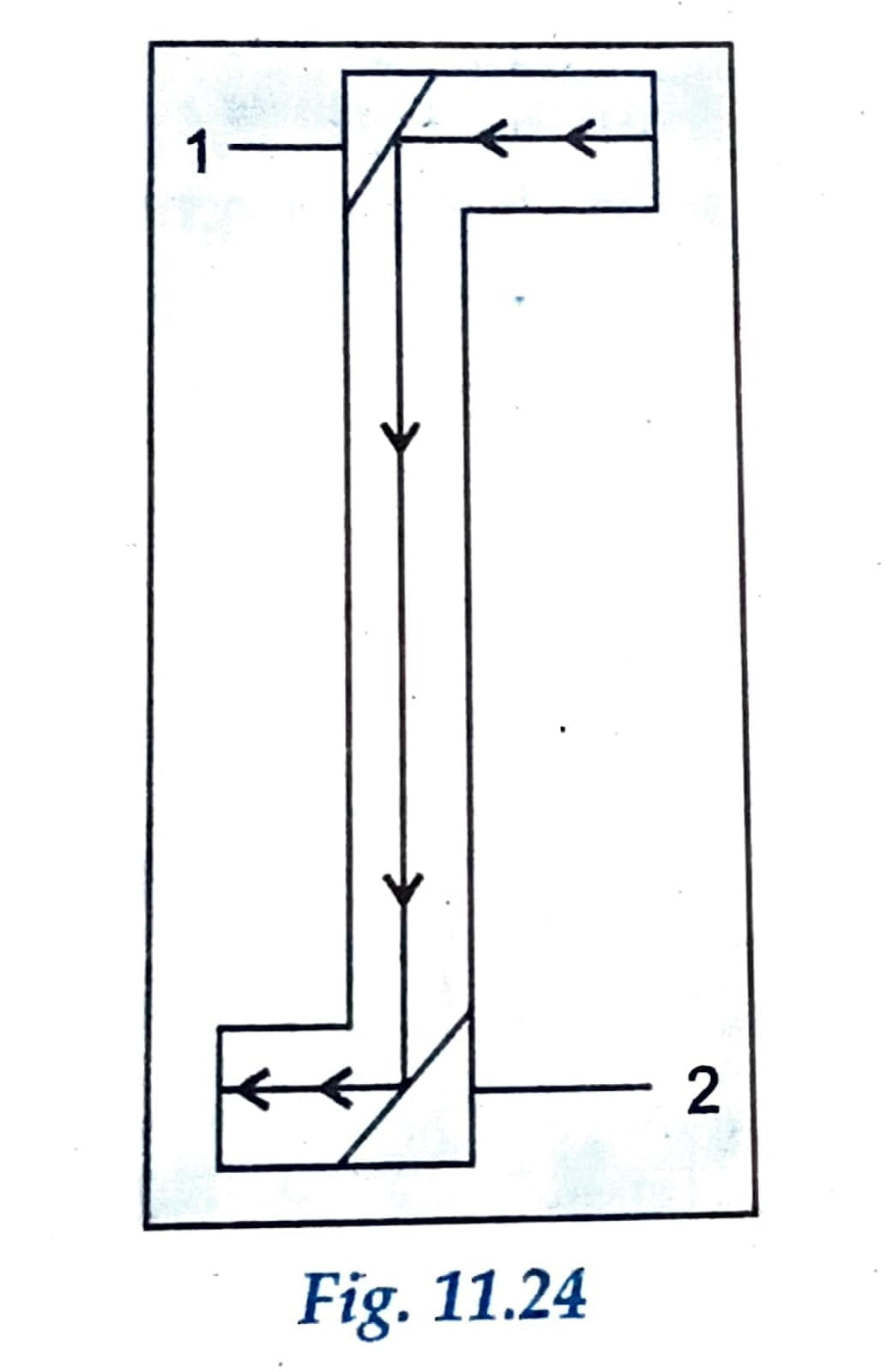
Ans: 1-mirror, 2-mirror, caption-Periscope.
It is used in submarines to see the objects above water.
FORMATIVE ASSESSMENT
Q. 1. Fill in the following blanks with suitable words:
(i) Light travels in ____________.
Ans: Straight.
(ii) The formation of pinhole images and shadows are possible only if _____________ travel in a st line straigh path.
Ans: Light.
(iii) Light helps us ______________ objects.
Ans: See.
(iv) The image which cannot be projected onto a screen is called _____________ image.
Ans: Virtual.
(v) A piece of glass is transparent but a piece of cardboard is ____________.
Ans: Opaque.
(vi) The plane mirror forms a ____________ image.
Ans: Virtual.
(vii) Objects that emit light of their own are called _________ objects.
Ans: Luminou.
(viii) Shadows are formed when an _____________object comes in the path of light.
Ans: Opaque.
(ix) The image formed by a mirror is due to ____________.
Ans: Reflection.
(x) The umbra is the ____________ portion of the shadow.
Ans: Darkest.
Q. 2. State whether the following statements are true or false
(i) The moon is a luminous object.
Ans: False.
(ii) A pinhole camera uses a lens to form a real and inverted image.
Ans: False.
(iii) The sun is the natural source of light.
Ans: True.
(iv) Those materials which allow all the light to pass through them are called transpare materials.
Ans: True.
(v) We cannot see clearly through a translucent material.
Ans: True.
(vi) Black thick paper is translucent.
Ans: False.
(vii) Moon is a luminous body.
Ans: False.
(viii) The shadow of a coloured object is also coloured.
Ans: False.
(ix) The shadow of an object can be seen only on a screen.
Ans: True.
(x) Sunlight can pass through water.
Ans: True.
Q. 3. Match the items given in column A with those in column B:
| Column A | Column B |
| 1. The sun | (a) Light and an opaque object. |
| 2. Object through which we cannot see clearly. | (b) Travels in straight line. |
| 3. Shadows. | (c) Changes direction of light. |
| 4. Light. | (d) Opaque. |
| 5. Mirror. | (e) Luminous. |
Ans:
| Column A | Column B |
| 1. The sun | (e) Luminous. |
| 2. Object through which we cannot see clearly. | (d) Opaque. |
| 3. Shadows. | (a) Light and an opaque object. |
| 4. Light. | (b) Travels in straight line. |
| 5. Mirror. | (c) Changes direction of light. |
Q. 4. Write one word for the following:
(i) A substance that allows light to pass through it.
Ans: Transparent.
(ii) The substance that allows only a part of light to pass through it.
Ans: Translucent.
(iii) It fills the space between the opaque object and the screen.
Ans: Shadow.
(iv) It travels in a straight line with a speed of 3 x 10 m/s.
Ans: Light.
(v) The ray of light that returns after falling on a mirror.
Ans: Reflected ray.
(vi) The region of total darkness in a shadow.
Ans: Umbra.
(vi) The region of partial darkness which surrounds the umbra.
Ans: Penumbra.
(vii) Any highly polished surface from which regular reflection takes place.
Ans: Mirror.
(x) Any source of light bigger than a point source of light.
Ans: Extended source of light.
(x) Objects that do not allow light to pass through them at all.
Ans: Opaque.
MULTIPLE CHOICE QUESTIONS
(i) Which one is the natural source of light?
(a) Tube light.
(b) Electric bulb.
(c) Sun.
(d) None of the above.
Ans: (c) Sun.
(ii) Which of the following material allows light to pass through it?
(a) Copper.
(b) Wood.
(c) Rubber.
(d) Glass.
Ans: (d) Glass.
(iii) The sun in the early morning can cause a building to form a shadow. This shadow will be:
(a) Fat.
(b) Long.
(c) Thin.
(d) Short.
Ans: (d) Long.
(iv) There is light on the earth even on a dark, cloudy day. This is because clouds are:
(a) Opaque.
(b) Transparent.
(c) Translucent.
(d) Luminous.
Ans: (c) Translucent.
(v) Which of the following are translucent materials?
(A) Air.
(B) Ground glass.
(D) Aluminium sheet.
(C) Clouds.
(a) A and B.
(b) B and C.
(c) A and C.
Ans: (b) B and C.
(vi) Which of the following is not a characteristic of a virtual image formed by a plane mirror?
(a) Cannot be formed on a screen.
(b) It is inverted.
(c) It is same size as the object.
(d) Is laterally inverted.
Ans: (b) It is inverted.
(vii) The object that does not give out light on its own is the
(a) Star.
(b) Lighted match stick.
(c) Light bulb.
(d) Shining mirror.
Ans: (d) Shining mirror.
(viii) Shadows give us information about:
(a) Shape of the source.
(b) Shape of object.
(c) Surface.
(d) Size of object.
Ans: (b) Shape of object.
(ix) We can see object in a bright room because:
(a) The objects give off a light to the air.
(b) The objects reflect the light falling on them.
(c) The objects send light away from our eyes.
(d) Our eyes give off light to the objects.
Ans: The objects reflect the light falling on them.
(a) Which of the following will produce diffuse reflection of light?
(A) Plane mirror.
(B) Piece of paper.
(c) Sail water in lake.
(D) Leather bag.
(a) A and B.
(b) B and C.
(c) A and D.
(d) DB and D.
Ans: (b) B and D.
VALUE BASED QUESTIONS
On a week end four friends went on a long drive in a car. Ashok was driving the car while the other three friends were sitting in the car. Suddenly Ashok observed from his side mirror that a car, which was behind their car, had met with an accident. Ashok immediately stopped his car. Ashok and his friends went to the car which had met with an accident. They managed to take the persons of that car to a nearby hospital, where they were provided proper medical care.
(i) What is the nature of the side mirror in a car?
Ans: The side mirror is a convex mirror.
(ii) What is the main purpose of the side view mirror of a car?
Ans: The side view mirror of a car is used to enable the car driver to see traffic behind him/ her to facilitate safe driving.
(iii) What values were exhibited by Ashok and his friends?
Ans: Ashok was considerate and had a presence of mind as well as ability to take a quick decision Ashok and his friends were helpful to needy persons.

Hi! my Name is Parimal Roy. I have completed my Bachelor’s degree in Philosophy (B.A.) from Silapathar General College. Currently, I am working as an HR Manager at Dev Library. It is a website that provides study materials for students from Class 3 to 12, including SCERT and NCERT notes. It also offers resources for BA, B.Com, B.Sc, and Computer Science, along with postgraduate notes. Besides study materials, the website has novels, eBooks, health and finance articles, biographies, quotes, and more.


